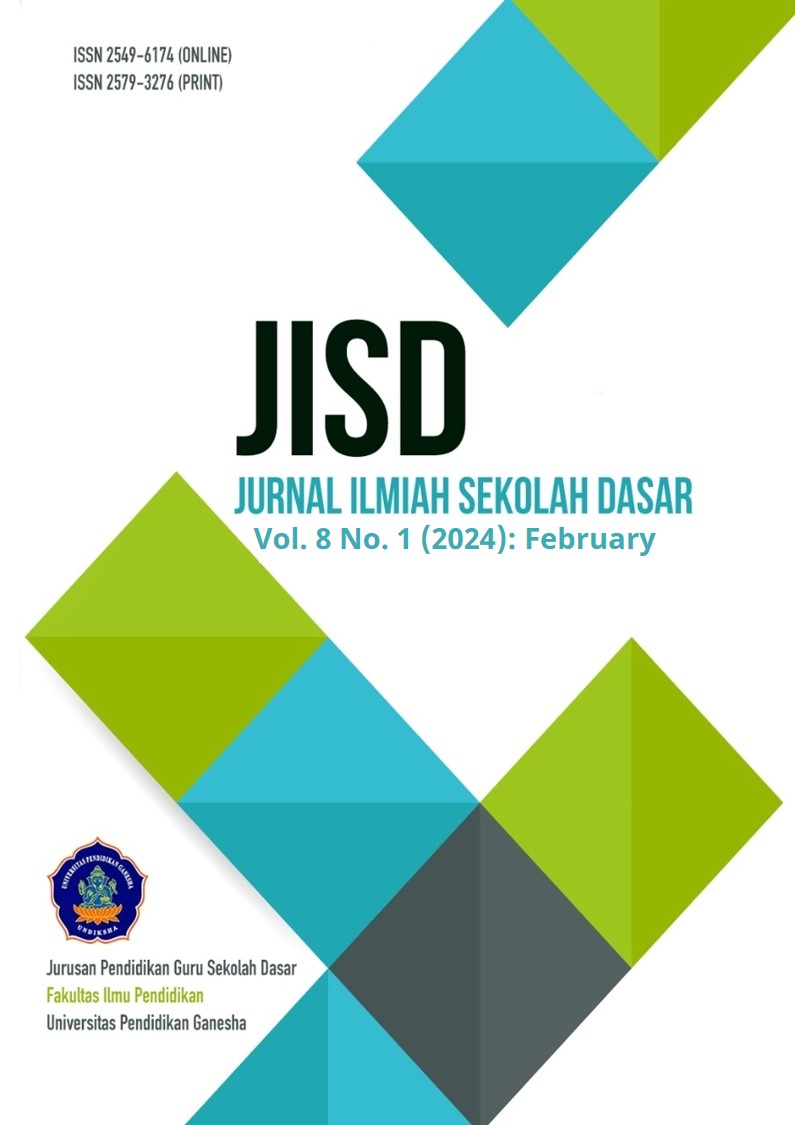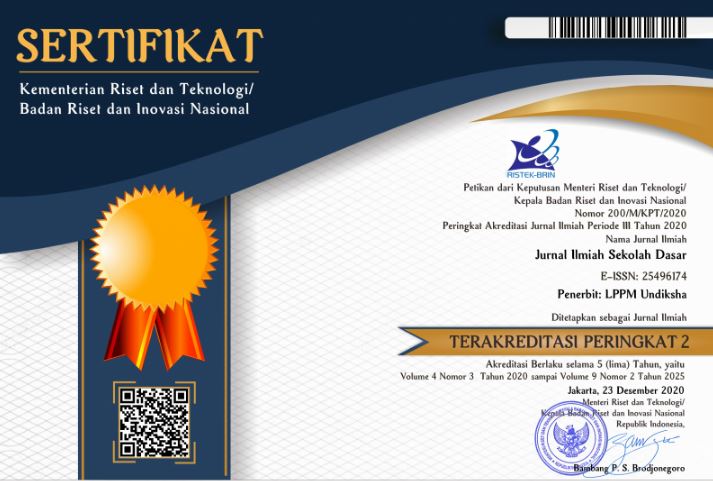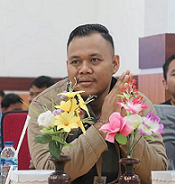The Impact of Augmented Reality in English Learning in Elementary Schools
DOI:
https://doi.org/10.23887/jisd.v8i1.66710Kata Kunci:
Augmented Reality, Elementary School, English Language Learning MediaAbstrak
The role of language as the most important means of effective communication is universally recognized. In the context of education, students are expected to recognize the potential for acquiring English with the help of the media. Media is a tool for learning English. The use of media in learning English is minimal. The aim is to find out the results of applying augmented reality as a medium for learning English in elementary schools. The method in this research is mixed methods namely survey, observation, and documentation. The subjects of this study were a teacher and elementary school students in English subject. Data collection techniques, nonverbal in the form of pictures, assisted by recording techniques, with the listening method. Data collection instruments used questionnaires and interview sheets. Multimodal analysis techniques and interview results were collected, reduced, and concluded. The results of the study show that teachers can use learning media based on augmented reality in learning English well. There is an increase in student learning outcomes in English subjects after using augmented reality-based learning media. So, can be concluded that the increased satisfaction levels among educators and students, reflecting a more interesting and satisfying learning environment.
Referensi
Alduais, A., Al-Qaderi, I., & Alfadda, H. (2022). Pragmatic Language Development: Analysis of Mapping Knowledge Domains on How Infants and Children Become Pragmatically Competent. Children, 9(9), 1–41. https://doi.org/10.3390/children9091407. DOI: https://doi.org/10.3390/children9091407
Aquilani, B., Piccarozzi, M., Abbate, T., & Codini, A. (2020). The role of open innovation and value co-creation in the challenging transition from industry 4.0 to society 5.0: Toward a theoretical framework. Sustainability (Switzerland), 12(21), 1–21. https://doi.org/10.3390/su12218943. DOI: https://doi.org/10.3390/su12218943
Badem-Korkmaz, F., & Balaman, U. (2020). Third position repair for resolving troubles in understanding teacher instructions. Linguistics and Education, 60(December 2020), 100859.1-13. https://doi.org/10.1016/j.linged.2020.100859. DOI: https://doi.org/10.1016/j.linged.2020.100859
Bashori, M., van Hout, R., Strik, H., & Cucchiarini, C. (2021). Effects of ASR-based websites on EFL learners’ vocabulary, speaking anxiety, and language enjoyment. System, 99(July 2021), 102496.1-16. https://doi.org/10.1016/j.system.2021.102496. DOI: https://doi.org/10.1016/j.system.2021.102496
Bates, V., Hickman, C., Manchester, H., Prior, J., & Singer, S. (2020). Beyond landscape’s visible realm: Recorded sound, nature, and wellbeing. Health and Place, 61(November 2019), 102271.1-7. https://doi.org/10.1016/j.healthplace.2019.102271. DOI: https://doi.org/10.1016/j.healthplace.2019.102271
Cenoz, J., & Santos, A. (2020). Implementing pedagogical translanguaging in trilingual schools. System, 92(August 2020), 102273.1-9. https://doi.org/10.1016/j.system.2020.102273. DOI: https://doi.org/10.1016/j.system.2020.102273
Che Dalim, C. S., Sunar, M. S., Dey, A., & Billinghurst, M. (2020). Using augmented reality with speech input for non-native children’s language learning. International Journal of Human Computer Studies, 134(February 2020), 44–64. https://doi.org/10.1016/j.ijhcs.2019.10.002. DOI: https://doi.org/10.1016/j.ijhcs.2019.10.002
Cheng, L., Antonenko, P. D., Ritzhaupt, A. D., Dawson, K., Miller, D., MacFadden, B. J., Grant, C., Sheppard, T. D., & Ziegler, M. (2020). Exploring the influence of teachers’ beliefs and 3D printing integrated STEM instruction on students’ STEM motivation. Computers and Education, 158(April), 103983.1-18. https://doi.org/10.1016/j.compedu.2020.103983. DOI: https://doi.org/10.1016/j.compedu.2020.103983
Chien, S. Y., Hwang, G. J., & Jong, M. S. Y. (2020). Effects of peer assessment within the context of spherical video-based virtual reality on EFL students’ English-Speaking performance and learning perceptions. Computers and Education, 146(March 2020), 103751.1-48. https://doi.org/10.1016/j.compedu.2019.103751. DOI: https://doi.org/10.1016/j.compedu.2019.103751
Danaei, D., Jamali, H. R., Mansourian, Y., & Rastegarpour, H. (2020). Comparing reading comprehension between children reading augmented reality and print storybooks. Computers and Education, 153(April), 103900.1-10. https://doi.org/10.1016/j.compedu.2020.103900. DOI: https://doi.org/10.1016/j.compedu.2020.103900
Desmiyanti, D., Yuanita, Y., & Anwar, K. (2020). Make a Match Learning for English Conversation Skills of Students with Intellectual Disabilities. Script Journal: Journal of Linguistics and English Teaching, 5(1), 23–31. https://doi.org/10.24903/sj.v5i1.378. DOI: https://doi.org/10.24903/sj.v5i1.378
Dwi, S., Eko, R., Adi, K. R., & Ratnawati, N. (2021). Pengembangan Media Evaluasi Pembelajaran IPS “ MAPS ” dengan Game Web Browser Based Learning untuk siswa SMP Development of Social Studies Evaluation Media “ MAPS ” with Game Web Browser Based Learning for Junior High School Students. 25–42. https://doi.org/10.15548/jpips.v8i1.12266. DOI: https://doi.org/10.18860/jpips.v8i1.12266
Fukuda, K. (2020). Science, technology and innovation ecosystem transformation toward society 5.0. International Journal of Production Economics, 220(April), 107460.1-14. https://doi.org/10.1016/j.ijpe.2019.07.033. DOI: https://doi.org/10.1016/j.ijpe.2019.07.033
Hu, X., & McGeown, S. (2020). Exploring the relationship between foreign language motivation and achievement among primary school students learning English in China. System, 89(April 2020), 102199.1-10. https://doi.org/10.1016/j.system.2020.102199. DOI: https://doi.org/10.1016/j.system.2020.102199
Huang, S. Y., Kuo, Y. H., & Chen, H. C. (2020). Applying digital escape rooms infused with science teaching in elementary school: Learning performance, learning motivation, and problem-solving ability. Thinking Skills and Creativity, 37(129), 100681.1-17. https://doi.org/10.1016/j.tsc.2020.100681. DOI: https://doi.org/10.1016/j.tsc.2020.100681
Hussein, E., Daoud, S., Alrabaiah, H., & Badawi, R. (2020). Exploring undergraduate students’ attitudes towards emergency online learning during COVID-19: A case from the UAE. Children and Youth Services Review, 119(December 2020), 105699.1-21. https://doi.org/10.1016/j.childyouth.2020.105699. DOI: https://doi.org/10.1016/j.childyouth.2020.105699
Kaya, T. (2020). The changes in the effects of social media use of Cypriots due to COVID-19 pandemic. Technology in Society, 63(April), 101380.1-7. https://doi.org/10.1016/j.techsoc.2020.101380. DOI: https://doi.org/10.1016/j.techsoc.2020.101380
Li, M. (2020). Multimodal pedagogy in TESOL teacher education: Students’ perspectives. System, 94(November 2020), 102337.1-13. https://doi.org/10.1016/j.system.2020.102337. DOI: https://doi.org/10.1016/j.system.2020.102337
Lumbantoruan, J. H. (2022). Mathematics Module Development Derivative Materials Christian University Of Indonesia, Jakarta, Indonesia E-Mail: Abstract Introduction In Purwaningsih's Research, (2016) It Was Seen That There Was An Increase In Student Activity In Learning Assisted By modules. AKSIOMA: Jurnal Program Studi Pendidikan Matematika, 11(4), 2593–2609. https://doi.org/http://dx.doi.org/10.24127/ajpm.v11i4.5716. DOI: https://doi.org/10.24127/ajpm.v11i4.5716
Lumbantoruan, J. H., & Nadeak, B. (2022). Mathematics teacher competency analysis during online learning. International Journal of Trends in Mathematics Education Research, 5(2), 214–221. https://doi.org/10.33122/ijtmer.v5i2.132. DOI: https://doi.org/10.33122/ijtmer.v5i2.132
Manuli, A., Maggio, M. G., Latella, D., Cannavò, A., Balletta, T., De Luca, R., Naro, A., & Calabrò, R. S. (2020). Can robotic gait rehabilitation plus Virtual Reality affect cognitive and behavioural outcomes in patients with chronic stroke? A randomized controlled trial involving three different protocols. Journal of Stroke and Cerebrovascular Diseases, 29(8), 1–9. https://doi.org/10.1016/j.jstrokecerebrovasdis.2020.104994. DOI: https://doi.org/10.1016/j.jstrokecerebrovasdis.2020.104994
Markowitz, A. J., & Ansari, A. (2020). Changes in academic instructional experiences in Head Start classrooms from 2001–2015. Early Childhood Research Quarterly, 53(Quarter 2020), 534–550. https://doi.org/10.1016/j.ecresq.2020.06.008. DOI: https://doi.org/10.1016/j.ecresq.2020.06.008
Meneses. (2018). The effects of multimodal texts on science reading comprehension in Chilean fifth-graders: Text scaffolding and comprehension skills. International Journal of Science Education, 40(18). DOI: https://doi.org/10.1080/09500693.2018.1527472
Murica. (2018). Interactive and multimodal pedagogy: A case study of how teachers and students use interactive whiteboard technology in primary science. Australian Journal of Education, 58(1), 74–88. DOI: https://doi.org/10.1177/0004944113517834
Ningsih. (2018). Pengaruh perkembangan revolusi industri 4.0 dalam dunia teknologi Pendidikan di indonesia. Junal Fakultas Komputer, 1–12. DOI: https://doi.org/10.31219/osf.io/pswmu
O’Brien, R., Beeke, S., Pilnick, A., Goldberg, S. E., & Harwood, R. H. (2020). When people living with dementia say ‘no’: Negotiating refusal in the acute hospital setting. Social Science and Medicine, 263(June), 113188.1-10. https://doi.org/10.1016/j.socscimed.2020.113188. DOI: https://doi.org/10.1016/j.socscimed.2020.113188
Parmaxi, A., & Demetriou, A. A. (2020). Augmented reality in language learning: A state-of-the-art review of 2014–2019. Journal of Computer Assisted Learning, 36(6), 861–875. https://doi.org/10.1111/jcal.12486. DOI: https://doi.org/10.1111/jcal.12486
Phoocharoensil, S. (2022). ELT and AL Research Trends in Thai SCOPUS-indexed Journals. Pasaa, 64(December), 163–193. https://eric.ed.gov/?id=EJ1376445.
Rambe, R. . (2019). Analysis Multimodal In School (Cendekia Press (ed.)).
Rao, H. R., Vemprala, N., Akello, P., & Valecha, R. (2020). Retweets of officials’ alarming vs reassuring messages during the COVID-19 pandemic: Implications for crisis management. International Journal of Information Management, 55(June), 102187.1-6. https://doi.org/10.1016/j.ijinfomgt.2020.102187. DOI: https://doi.org/10.1016/j.ijinfomgt.2020.102187
Rovira, M. S., Turro, M. R., Fioretti, R. M. S., & Velilla, M. C. (2018). Multimodal Campus Project: Pilot Test of Voice Supported Reading. Procedia - Social and Behavioral Sciences, 190, 190–197. DOI: https://doi.org/10.1016/j.sbspro.2015.07.027
Sari, S. . (2020). Analisis Multimodal. Journal Of Reflection : Ekonomic, Accounting, Management Business, 3, 291–300. DOI: https://doi.org/10.37481/sjr.v3i3.224
Seuren, L. M., Wherton, J., Greenhalgh, T., & Shaw, S. E. (2021). Whose turn is it anyway? Latency and the organization of turn-taking in video-mediated interaction. Journal of Pragmatics, 172(January 2021), 63–78. https://doi.org/10.1016/j.pragma.2020.11.005. DOI: https://doi.org/10.1016/j.pragma.2020.11.005
Sugiyono. (2015). Metode Penelitian dan pengembangan. Alfabeta.
Sugiyono. (2017). Metode Penelitian Kuantitatif, kualitatif dan R&D. Alfabeta.
Suryana & Indrawati. (2018). Pengembangan Media Pembelajaran Berbasis Permainan Tradisional “Geprek Kaleng” untuk menanamkan konsep Pecahan Siswa Kelas III SD. JPGSD Surabaya, 06(03), 219-228.
Syamsuar, & R. (2018). Pendidikan Dan Tantangan Pembelajaran Berbasis Teknologi Informasi Di Era Revolusi Industri 4.0. E-Tech : Jurnal Ilmiah Teknologi Pendidikan, 6(2). DOI: https://doi.org/10.24036/et.v2i2.101343
Thees, M., Kapp, S., Strzys, M. P., Beil, F., & Lukowicz, P. (2020). Computers in Human Behavior Effects of augmented reality on learning and cognitive load in university physics laboratory courses. Computers in Human Behavior, 108(July 2020), 106316.1-11. https://doi.org/10.1016/j.chb.2020.106316. DOI: https://doi.org/10.1016/j.chb.2020.106316
Verawati dan Desprayoga. (2019). Solusi Pembelajaran 4.0: Hybrid Learning. Prosiding Seminar Nasional Pendidikan Program Pascasarjana Universitas Pgri Palembang, 1183–1192.
Yang, Q. F., Chang, S. C., Hwang, G. J., & Zou, D. (2020). Balancing cognitive complexity and gaming level: Effects of a cognitive complexity-based competition game on EFL students’ English vocabulary learning performance, anxiety and behaviors. Computers and Education, 148(December 2019), 103808.1-21. https://doi.org/10.1016/j.compedu.2020.103808. DOI: https://doi.org/10.1016/j.compedu.2020.103808
Unduhan
Diterbitkan
Cara Mengutip
Terbitan
Bagian
Lisensi
Hak Cipta (c) 2024 Hendrikus Hendrikus Male

Artikel ini berlisensiCreative Commons Attribution-ShareAlike 4.0 International License.
Authors who publish with the Journal Ilmiah Sekolah Dasar agree to the following terms:
- Authors retain copyright and grant the journal the right of first publication with the work simultaneously licensed under a Creative Commons Attribution License (CC BY-SA 4.0) that allows others to share the work with an acknowledgment of the work's authorship and initial publication in this journal.
- Authors are able to enter into separate, additional contractual arrangements for the non-exclusive distribution of the journal's published version of the work (e.g., post it to an institutional repository or publish it in a book), with an acknowledgment of its initial publication in this journal.
- Authors are permitted and encouraged to post their work online (e.g., in institutional repositories or on their website) prior to and during the submission process, as it can lead to productive exchanges, as well as earlier and greater citation of published work. (See The Effect of Open Access)











